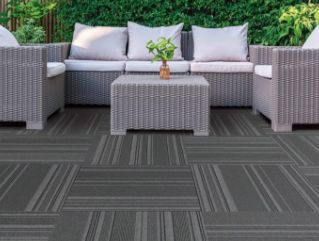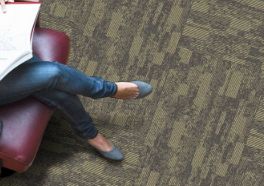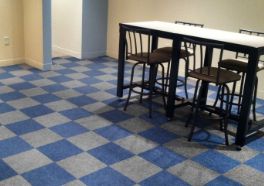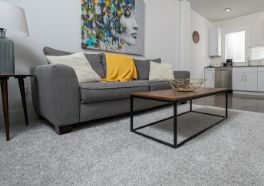Shop Carpet Tiles

All Carpet Tiles
- Easy to install
- Stylish
- Affordable
Shop All

Commercial Carpet Tiles
- Durable
- Can handle high traffic
- Low-maintenance
Shop Commercial

Peel and Stick Carpet Tiles
- Self-adhesive backing
- DIY-friendly
- For residential use
Shop Peel and Stick

Outdoor Carpet Tiles
- Water-resistant
- Won’t mold or mildew
- Indoor-outdoor carpet options
Shop Outdoor

Carpet Planks
- More pattern options
- Easy to remove and replace
- Simple to maintain
Shop All Carpet Planks
Customer Favorite Carpet Tiles
Carpet Tiles Reviews
Carpet Tile FAQs
Carpet Tile Overview
Carpet tiles are an easy DIY flooring that can be installed in record time. Just simply peel and stick, glue, tape, or lock your tiles down and you’re ready to go.
Carpet squares are not exactly new in commercial spaces, but now they’re finding their way into residential areas as well. Why is this? Let’s go over all things carpet tile and find out why you should consider carpet tile for your next flooring project.
Carpet squares are not exactly new in commercial spaces, but now they’re finding their way into residential areas as well. Why is this? Let’s go over all things carpet tile and find out why you should consider carpet tile for your next flooring project.
Carpet Tile Pros and Cons
What are the advantages of carpet squares?
- Easy to install: They are extremely DIY-friendly. So easy, it can be done in a matter of hours! Since they often have backing and (depending on the tile) adhesive included, there are no extra tools needed for installation.
- Custom looks: Because carpet tiles come in a variety of colors, textures, and patterns, you can get as creative as you want when it comes to carpeting your home. They are very popular for creating custom area rugs.
- Easy to replace: Accidents happen, like your dog knocking over a glass of juice. Instead of living with the stain, or having to replace the entire carpet, simply remove the damaged carpet square and replace it with a brand new one.
- Waste less: Broadloom carpet is sold in rolls that must be cut down to fit your space. With carpet tiles, you can get just the right amount to fit your room and not have extra carpet hanging out in your garage for all eternity.
- Price: On a tight budget? Don’t worry. You can cover your floor cheaply with carpet tiles, without having to sacrifice quality.
What are the drawbacks of carpet squares?
- Comfort: Carpet squares typically aren’t as thick or plush as broadloom carpet rolls, so they aren’t as soft underfoot. However, there are a few options for plush carpet tiles, and you can also purchase carpet padding to go underneath the tiles to address this.
Carpet Tile Material
Carpets are made from a few different kinds of fiber. Depending on where you intend to install your carpet, and how durable it needs to be, one fiber material may be more suitable than others.- Nylon: Nylon remains the most popular fiber of choice. It is highly durable, static-free, and great for indoor carpets. Nylon is usually treated with a stain-blocking technology that helps it stay beautiful, longer.
- Polyester: Polyester is mostly made from recycled materials, and it’s gaining in popularity. This fiber is slightly less expensive than nylon, and almost just as durable. With the widest range of color choices, and extreme stain-resistance and fade-resistance, polyester will ensure a great-looking carpet for years to come.
- Polypropylene: Polypropylene is a stain- and fade-resistant fiber because the color runs through the fiber rather than outside the fiber. This carpet fiber is soft and durable, but one downside is that it attracts and absorbs oil, which can leave it looking dingy.
Carpet Tile Backing
Okay, now that fiber has been covered, let’s learn about carpet backing. You can choose from many different backings, but they all have the same function: keeping the carpet tile and floor together.We offer these backings:
- PVC: PVC is a kind of durable plastic that is made to last. It’s also pretty cheap to manufacture, which should make the carpet more affordable.
- Plastic (PVC-Free): PVC-free plastic is recyclable, which means your carpet tile is more eco-friendly.
- Polyurethane cushion: More cushioning! With this backing, the carpet pad is attached to the tile to create plush carpet tiles.
- Bitumen: This used to be one of the most common carpet backing materials, but it has mostly been replaced by PVC.
- Rubber: This backing combines the durability of rubber with the softness of carpeting. The rubber backing provides some anti-fatigue properties and is great for high-traffic areas.
- Foam: Foam-backed tiles offer the comfort of foam flooring with the extra durability of carpet on the surface.
- Polypropylene: This tough plastic backing provides durability and impact resistance. In some cases, the backing is part of an interlocking peg and loop system.
How to Install Carpet Tiles
There are three main installation methods that don’t involve glue, and the best option for you will depend on the traffic level, and how much effort you want to put in.Peel and Stick Carpet Tiles
Self-adhesive carpet tiles, a.k.a. peel and stick tiles are the easiest to install. The adhesive is already applied to each tile and all you have to do is pull back the plastic sheet to expose it.
Simply place the peel and stick carpet square on the floor, and press down to adhere it to the floor. That’s all there is to it!
Some adhesives leave a residue on the subfloor but some do not. However, there’s an easy way to test! Place your hand on the adhesive; if your hand is sticky after, it will leave a residue that is easily cleaned up if needed.
Shop Peel and Stick Carpet
Interlocking Carpet Tiles
Interlocking tiles look one of two ways: like a giant puzzle piece, or with plastic attachments on the sides that click into one another.
For the tiles with interlocking edges, lay them out and join the edges together as if you’re putting together a puzzle. These are so easy to put together, a child could do it! Tiles sometimes come with a finished edge, or you can cut them to create a clean edge.
If the tile has a plastic backing, just click them together using the locking mechanisms on the side.
Shop Interlocking Carpet
Glue-Free Carpet Tiles
These tiles don’t have interlocking edges or pre-applied adhesive. Usually, they would be glued down, but this doesn’t have to be the case. To install carpet tiles without glue, use double-sided carpet tape around the edges of each tile. If you secure tiles using the tape method, you can make a custom-made area rug.
With the taping method, you can finish a room quickly without the glue. However, if you really want them to permanently stick, you can still use glue or pressure-sensitive adhesive to keep the tiles in place.
Shop Glue-Free Carpet
Application
Residential Carpet TilesA residential carpet is all about comfort and style. When you’re at home, you want plush carpet tiles, something soft underfoot that will also provide some insulation so you’re not walking on a cold, hard floor. For these reasons, residential carpet squares often have soft tufted fibers and a high pile, so it’s thick and fluffy.
Shop All Carpet Tiles
Commercial Carpet Tiles
In a commercial space, carpet tiles need to be heavy-duty, easy to maintain, and affordable. That’s the kind of product business owners want. Since there’s likely to be a lot of foot traffic, a low pile or loop pile carpet like Beber would be best, because it will resist crushing and matting. Commercial carpet squares are typically glued down to ensure the most stability.
Shop Commercial Carpet Tiles
Outdoor Carpet Tiles
Outdoor carpet is mold- and mildew-resistant, and even water-resistant. It’s built to battle the elements. Most carpet for the outdoors is going to be a low pile or Berber carpet, to handle wear and tear and dirt.
You’ll also want to make sure the fiber is UV stable, meaning it won’t fade in the sun. Most Nylon fibers fade in direct sunlight, so you wouldn’t want that outdoors.
Shop Outdoor Carpet Tile
Carpet Tile Trends

Geometric
Bold patterns with geometric shapes are all the rage these days. Especially if you’re looking for a flooring that will match your modern or contemporary space, consider some linear or checkered patterns. Shop Geometric Carpet Tile

Berber
The Berber or looped carpet texture won’t ever really go out of style. It’s trendy right now not just because it’s minimalistic and classic, but also because the looped texture increases the durability of your floor. Shop Berber Carpet Tile

Solid Color
Sometimes the simplest option is the best. That might mean choosing solid color tiles for a wall to wall carpet. However, you can always get adventurous by mixing and matching colors to create your own custom look. Shop Solid Color Carpet Tile


